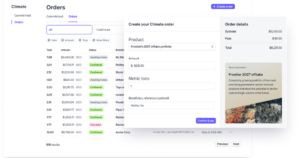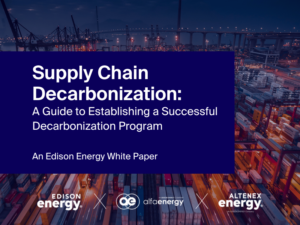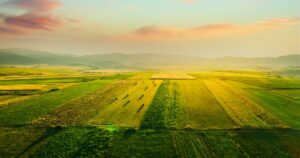
Reducing global methane emissions has become a key priority for policymakers in the U.S. and abroad, intensifying the scrutiny of an already scrutinized source of the gas: the bovine digestive system.
Yes, lately it seems a whole lot of folks — scientists, entrepreneurs, multinational food companies and the United Nations — are all up in Bessie’s business.
Meat and dairy producers have come under increasing pressure to cut greenhouse gas (GHG) emissions, methane in particular, and with the new Global Methane Pledge, that pressure will only intensify. More than 100 countries have promised to curb these emissions by at least 30 percent by the end of the decade, with dozens signing on at the U.N. climate summit, a.k.a. COP26, taking place in Glasgow.
As the barnyard’s most productive emitters of methane, cows and their digestive tracts are the focus of an abundance of new research and development. Potential solutions, such as feed additives derived from a type of seaweed known as Asparagopis and a methane-inhibiting molecule known as 3-NOP, look especially promising.
Although it’s still early days for these novel solutions, a lot of potential exists.
We did have a regenerative food system, and the buffalo was that regenerative system.
In a new report, the Breakthrough Institute in Oakland, California, estimates that full adoption of existing low-carbon technologies and practices along with emerging tech by 2030 could reduce beef production’s greenhouse gas footprint by roughly 48 percent. Their list of existing practices includes grazing optimization, cover crops on feed cropland and composting manure. In addition to new feed additives, emerging tech includes efficient production of those additives with low-carbon electricity, breeding lower-methane cattle and anaerobic digestion, which converts animal waste to methane gas used for energy.
The push to reduce emissions from animal agriculture is happening alongside a connected trend: Consumers who can afford the markup are increasingly opting for products they believe offer better health alongside animal wellbeing and environmental sustainability, such as free-range chicken and eggs, or beef and milk from grass-fed cows.
But the meat industry itself often treats GHG mitigation and animal welfare as two separate issues, as Mark McKay, president of Perdue Premium Poultry and Meats, which produces the company’s organic and sustainable lines, said at GreenBiz’s VERGE 21 virtual event in October: “Usually we talk about animal care or we talk about things that we’re doing from an environmental standpoint, but this connectivity part, how those two things are interrelated, is really intriguing.”
While there’s myriad available and emerging solutions, the real key to cutting animal ag’s GHG footprint is reducing the number of animals raised for food, researchers say. This sounds simple enough, but in the real world, to both lower emissions and take good care of our four-legged friends would require all the pieces of a complex puzzle falling into place — a mix of science, technology, public policy and lifestyle changes coming together to create a food system that can feed a growing human population, using a smaller number of animals and the same amount of land or less.
Dan Blaustein-Rejto, director of food and agriculture at the Breakthrough Institute and one of the authors of the report, is firmly and appropriately skeptical of this happening.
“There are tradeoffs between environmental impact and animal welfare sometimes,” he told me. “And there are tradeoffs between different types of environmental impact. It’s not always possible to have our cake and eat it too.”
Still, sometimes it doesn’t hurt to ask: What if?
Bad bovine burps
While carbon dioxide leads other GHGs in the overall planetary warming category, in agriculture CO2 takes the bronze, behind methane and nitrous oxide (which together comprise 88 percent of U.S. agricultural emissions).
Livestock accounts for most of the country’s ag emissions, with the main sources breaking down as follows: feed production and processing, including land use change, 45 percent; enteric fermentation from ruminant animals, 39 percent; and manure storage and processing, 10 percent.
In terms of the animals, cows are the main culprit, representing about 65 percent.
The meat industry itself often treats GHG mitigation and animal welfare as two separate issues.
Gassy cows and methane have been in the news for quite some time. As ruminants, cows’ bellies are home to a digestive process where microbes decompose and ferment food — enteric fermentation — which produces methane, released primarily by incessant burping, and less so from the other end, as commonly believed.
Methane lasts for only about a decade in the atmosphere, while carbon dioxide persists for centuries, but methane’s warming effect is more than 30 times greater. So reducing the amount of methane entering the atmosphere would yield climate effects almost immediately.
One way to do that is to make beef production more efficient.
Making Bessie beefier
Driven largely by population growth and increasing wealth, global demand for meat continues to climb. Plant-based proteins from the likes of Impossible Burger and others could slow the increase, although they haven’t so far. What has slowed in the United States, somewhat counter-intuitively, is the emissions intensity of beef production. Despite producing the largest share of the world’s beef, emissions intensity in the U.S. is actually lower than that of other major producers — Argentina, China, Brazil and India — and declining, largely due to a highly efficient industrialized system.
Ermias Kebreab, the Sesnon Endowed Chair in the animal science department at the University of California at Davis, would like to help farmers in other parts of the world produce beef more efficiently as well. He’s working with agriculture officials in Vietnam and Ethiopia to do just that.
“The increase in animal production is going to be in other parts of the world, where the production is very low, and the demand has been increasing,” said Kebreab, who made news earlier this year when he and a team of UC Davis researchers showed that adding seaweed to beef cattle’s diets could reduce their methane emissions by as much as 82 percent.
“We are trying to help farmers boost productivity by improving the nutrition, management and genetics of their animals” to increase how much milk and meat their cattle produce, Kebreab told me.
Most of the solutions are win-wins, but they require a reduction in the consumption of animal products,
If smallholder farmers in developing countries can improve animal health and nutrition and thereby reduce GHG emissions by raising fewer animals, that’s a win-win — especially if you factor in that the fewer cows you have, the less land you have to clear for them to graze.
Animal agriculture is a leading driver of deforestation, which both releases carbon and destroys habitat. The urgent need to curb the destruction of forests has made the issue a priority at COP26, with leaders from more than 100 countries signing on to a landmark agreement to end deforestation by 2030.
While the agreement has already drawn criticism, it does promise to do a whole lot that looks good on paper. Among other things, countries say they will create agricultural policies and programs to incentivize sustainable agriculture, promote food security and benefit the environment. They also aim to increase public and private investment in sustainable agriculture, forest conservation and restoration, and to support smallholders, Indigenous people and local communities.
Of course, the details of these plans, where the devil lies, remain unclear. But policies and programs that truly incentivize regenerative farming and grazing practices, and support small farmers and Indigenous people in these efforts, could have a huge impact from a social, environmental and animal welfare perspective. Indigenous people manage or own more than a quarter of the world’s lands, and a growing body of research shows that nature is healthier on those lands.
North America’s original regenerative food system
Dawn Sherman, CEO of Native American Natural Foods (NANF), understands this well.
From her home on the Pine Ridge Reservation in South Dakota, where NANF is based, Sherman looks at the U.S.’s burgeoning regenerative grazing movement and sees cattle producers “trying to teach their cattle to be buffalo.”
“When you talk about regenerative economies or regenerative agriculture, you’re really talking about indigenous practices,” Sherman told me. “You have to remember that we did have a regenerative food system, and the buffalo was that regenerative system.”
For thousands of years prior to the 19th century, an estimated 30 to 60 million buffalo roamed the Great Plains of North America, where a vast sea of lush grassland stretched from the southern reaches of present-day Canada down to the Texas panhandle. The lives of the region’s indigenous people intertwined culturally and existentially with the buffalo, which provided meat for food and pelts for clothing and shelter.
Alternative proteins could account for 11% of the global protein market by 2035.
Sherman described the role this keystone species played in the grassland ecosystem. As huge herds of bison traveled across the prairies, they grazed on grasses, fertilized the soil with their manure and wallowed in the dirt creating watering holes for birds and amphibians. Then, these seasonal grazers moved on.
As the grasses grew back, something else happened. The plants stored carbon from the air in their roots deep underground.
Today just over half the midwestern grasslands and prairies, roughly 360 million acres, remain intact, and 1.5 million acres are lost a year to massive-scale agricultural production, primarily of corn, wheat and soybeans. A 2019 University of Wisconsin study estimated that tillage for U.S. cropland expansion released as much CO2 into the atmosphere as 31 million cars. Still, the grasslands that remain continue to serve as a carbon sink.
As for the buffalo, an orchestrated slaughter by the U.S. government, meant to starve indigenous Americans into submission, brought their numbers down to under 1,000 by the end of the 19th century. Today they’ve rebounded to roughly 350,000.
Sherman and her colleagues aim to grow that number.
Best known for its Tanka line of buffalo meat and fruit bars, NANF has also created the Tanka Fund, a nonprofit that invests in bison producers in an effort “to repopulate the plains with buffalo and re-establish a sustainable buffalo economy to Native lives.”
Can the land-use conundrum be solved?
Of course, cows and other farm animals aren’t buffalo, and today we raise and eat a whole lot more of them, which takes up a lot of space. In the contiguous U.S., 41 percent of the land is used for feeding livestock — 654 million acres for pasture and 127 million acres to produce feed.
And land use is where things get really complicated, especially when you add animal welfare to the equation.
Returning to the idea of efficiency: U.S. beef is less carbon intensive primarily because, on average, American cows spend the last 40 percent of their lives crowded into large-scale feedlots, where they’re “fattened up” on grain, according to the Breakthrough Institute report. Only 3 percent of U.S. beef cattle are “grass fed,” or fed exclusively on grass and other forage.
And despite the well-known animal welfare and water pollution problems associated with industrialized feedlots, raising animals on these operations for part of their lives actually reduces methane emissions. Because fattening cattle up on grain means fewer animals are needed to produce the same amount of meat. Plus, grain is easier to digest than grass and forage, so it produces less gas.
Fewer cows plus less gas equals fewer emissions.
That said, new research shows that a regenerative system could be at least part of the answer under the right circumstances.
Late last year, researchers confirmed the findings of an earlier study done at White Oak Pastures in Georgia, which showed that using regenerative techniques, such as multi-species pasture rotations, the farm’s soil sequestered enough carbon to result in a GHG footprint 66 percent lower than with conventionally produced beef. But here’s the catch: White Oak required 2.5 times more land to do it.
While exactly how much carbon agricultural soil can sequester remains controversial, regenerative techniques — which include reducing synthetic fertilizers and pesticides, eschewing tilling, rotating crops, planting grasses and other cover crops, and often incorporating animals into the farming system — result in other benefits: improved soil and water quality, reduced nitrogen runoff and more habitat to foster biodiversity.
But could we raise all American beef via a regenerative food system?
The missing link: eat less meat
No, not at current production rates, we couldn’t. Research shows that there is simply not enough land available in the U.S. to shift beef production to an exclusively grass-fed system. A 2018 study found that current pastureland grass could support only 27 percent of today’s beef supply. However, with cropland-raised forage included — the pastures at places such as White Oak farm — that number shoots up to 61 percent.
That’s a big difference that means converting conventional agricultural land to regenerative operations could provide a huge chunk of grazing land without encroaching on natural ecosystems.
But even in an idyllic regenerative utopia it’s still only roughly 60 percent. Beyond science and tech, policy and land use, one key piece of the puzzle remains missing: People simply have to eat less meat — not no meat, but definitely less, especially in industrialized countries that consume a lot.
As huge herds of bison traveled across the prairies, they grazed on grasses, fertilized the soil with their manure and wallowed in the dirt creating watering holes for birds and amphibians.
“Most of the solutions are win-wins, but they require a reduction in the consumption of animal products,” Leah Garces, president of Mercy For Animals, told me. “They require a shift in our diets. If we try any other angle where we’re using technological interventions to somehow keep meat production at the same level, something will be sacrificed. There’s no way around reducing the consumption of animals in order to meet our emissions targets.”
Alternative proteins could provide part of that reduction, and a new iteration called “hybrids” might help move the shift along. The Better Meat Company, for example, produces plant-based meat enhancements that are blended with beef, pork, chicken or fish to reduce the amount of meat in the product while maintaining the natural flavor.
A report from Boston Consulting Group and Blue Horizon Corp. published earlier this year predicts that alternative proteins could account for 11 percent of the global protein market by 2035.
That’s not enough to make a regenerative utopia happen — we’d still need a larger overall reduction in meat consumption, as well as all the other pieces of the puzzle falling into place.
It does sound awfully daunting, but — what if?
Source: https://www.greenbiz.com/article/can-we-have-our-happy-beef-and-eat-it-too







